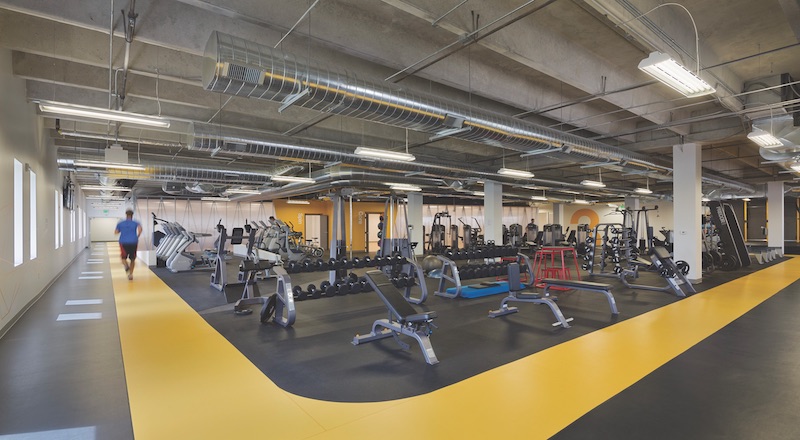Five years ago, 3form, a materials manufacturer, did a top-to-bottom remodel of its Salt Lake City headquarters campus that included adding a 14,500-sf gym, which was built with the company’s sustainable building products.
3form also instituted a policy that employees who used the gym and complied with certain health metrics would qualify for discounts on their monthly payroll contributions for healthcare coverage. In December 2018, 3form had saved so much money on healthcare costs as a result of this program that it was able to offer its employers free coverage for that month.
The savings equaled 8.3% of the workers’ gross pay in December.
Talley Goodson and Wynn Clayton, 3form’s CEO and CFO, “saw that something was happening on the horizon” about increasing healthcare costs when they approved the investment for the gym, says Christian Darby, the company’s Vice President of Design and Marketing. They took a “holistic approach” whose goal was to improve the overall health of 3form’s workforce, while controlling healthcare costs.
As of December the company employed 382 people and had a total of 909 covered under its healthcare plan. Family members can use the gym, which offers 24/7 access. The facility has eight contracted personal trainers whose jobs include evaluating the gym’s equipment each year for functionality and usage.
Beyond the gym, 3form provides its workers with an onsite doctors’ office for medical appointments, as well as blood tests and prescription refills. Services include follow-up care and counseling in the office or via telephone.
Darby says 3form has had the same healthcare provider for the past four years and into 2019. The company raised its employees’ payroll deduction for healthcare by only 3% in 2018—compared to the national average of 10-12%—and is not increasing that deduction for coverage in 2019.
Darby says participating employees are required to check in with the company’s clinic four times a year, during which 3form’s medical staff might suggest health “opportunities” for employees or their family members to pursue.
To get the discounts on premiums, employees must participate in a Health Risk Assessment to see if they fall outside of established standards for cholesterol, body mass, diabetes, asthma, hypertension, health of mind, eating habits, stress level, or tobacco use. If so, they enter a program and engage in a process that can include taking prescribed medicine or meeting with medical professionals.
In Darby’s case, the med staff found that his cholesterol was “a tad high,” he says, and established targets and a strategy to help lower it.
Related Stories
Office Buildings | Oct 29, 2024
Editorial call for Office Building project case studies
BD+C editors are looking to feature a roundup of office building projects for 2024, including office-to-residential conversions. Deadline for submission: December 6, 2024.
Office Buildings | Oct 21, 2024
3 surprises impacting the return to the office
This blog series exploring Gensler's Workplace Survey shows the top three surprises uncovered in the return to the office.
Sustainable Design and Construction | Oct 10, 2024
Northglenn, a Denver suburb, opens a net zero, all-electric city hall with a mass timber structure
Northglenn, Colo., a Denver suburb, has opened the new Northglenn City Hall—a net zero, fully electric building with a mass timber structure. The 32,600-sf, $33.7 million building houses 60 city staffers. Designed by Anderson Mason Dale Architects, Northglenn City Hall is set to become the first municipal building in Colorado, and one of the first in the country, to achieve the Core certification: a green building rating system overseen by the International Living Future Institute.
MFPRO+ News | Oct 9, 2024
San Francisco unveils guidelines to streamline office-to-residential conversions
The San Francisco Department of Building Inspection announced a series of new building code guidelines clarifying adaptive reuse code provisions and exceptions for converting office-to-residential buildings. Developed in response to the Commercial to Residential Adaptive Reuse program established in July 2023, the guidelines aim to increase the viability of converting underutilized office buildings into housing by reducing regulatory barriers in specific zoning districts downtown.
The Changing Built Environment | Sep 23, 2024
Half-century real estate data shows top cities for multifamily housing, self-storage, and more
Research platform StorageCafe has conducted an analysis of U.S. real estate activity from 1980 to 2023, focusing on six major sectors: single-family, multifamily, industrial, office, retail, and self-storage.
Government Buildings | Sep 17, 2024
OSHA’s proposed heat standard published in Federal Register
The Occupational Safety and Health Administration (OSHA) has published a proposed standard addressing heat illness in outdoor and indoor settings in the Federal Register. The proposed rule would require employers to evaluate workplaces and implement controls to mitigate exposure to heat through engineering and administrative controls, training, effective communication, and other measures.
Mass Timber | Sep 17, 2024
Marina del Rey mixed-use development is L.A.’s largest mass timber project
An office-retail project in Marina del Rey is Los Angeles’ largest mass timber project to date. Encompassing about 3 acres, the 42XX campus consists of three low-rise buildings that seamlessly connect with exterior walkways and stairways. The development provides 151,000 sf of office space and 1,500 sf of retail space.
Office Buildings | Sep 16, 2024
Maximizing office square footage through ‘agile planning’
Lauren Elliott, RID, NCIDQ, Director of Interior Design, Design Collaborative, shares tips for a designing with a popular and flexible workspace model: Agile planning.
Adaptive Reuse | Sep 12, 2024
White paper on office-to-residential conversions released by IAPMO
IAPMO has published a new white paper titled “Adaptive Reuse: Converting Offices to Multi-Residential Family,” a comprehensive analysis of addressing housing shortages through the conversion of office spaces into residential units.
Office Buildings | Sep 6, 2024
Fact sheet outlines benefits, challenges of thermal energy storage for commercial buildings
A U.S. Dept. of Energy document discusses the benefits and challenges of thermal energy storage for commercial buildings. The document explains how the various types of thermal energy storage technologies work, where their installation is most beneficial, and some practical considerations around installations.

















